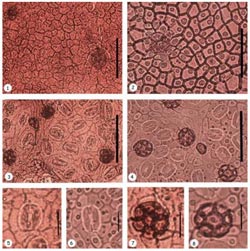

As the only direct evidence of past life, fossils provide important information on the interactions between plants and environmental change. After ten years' survey, Professor Zhou Zhekun's group from Kunming Institute of Botany has discovered more than ten well preserved Neogene plant fossil sites in southwestern China which are important to understand past climate and response of plants to the changing climate in this region.
Their recent work, entitled “Evolution of stomatal and trichome density of the Quercus delavayi complex since the late Miocene”, was published in CHINESE SCIENCE BULLETIN.2013, Vol 58(21).
Comparing closely related fossils from different geological periods is an efficient method to understand how plants respond to climatic change across a large scale. However, few studies have been carried out due to lack of a continuous fossil record. In their recent study, Prof. Zhou's group investigated detailed micro-morphology of a dominant element in Neogene fossil sites, Quercus delavayi complex (one oak species) to answer this question.
Their results show that Quercus delavayi complex from different periods share similar leaf morphology, but differ with respect to trichome and stomatal densities. The stomatal density of the Q. delavayi complex was the highest during the late Miocene, declined in the late Pliocene, and then increased during the present epoch. These values show an inverse relationship with atmospheric CO2 concentrations. Since the late Miocene, a gradual reduction in trichome base density has occurred in this complex. This trend is the opposite of that of precipitation, indicating that increased trichome density is not an adaptation to dry environments. These results are important to understand the relationship between plant evolution and climatic change which are important to predict the fate of current biodiversity in a changing environment.
This research project was partially supported by a grant from the National Natural Science Foundation of China and a 973 grant from Department of Science and Technology of China. Knowledge of the past is crucial to understand the future. The researchers suggest the old subject 'Paleontology' can reveal long term evolution in the past which is hardly seen in 'Neontology' should receive more attention.
See the article: Hu Q, Xing Y W, Hu J J, Huang Y J, Ma H J, Zhou Z K. Evolution of stomatal and trichome density of the Quercus delavayi complex since the late Miocene. Chin Sci Bull, 2013, 58, doi: 10.1007/s11434-013-6005-x
http://csb.scichina.com:8080/kxtb/CN/abstract/abstract511896.shtml
Science China Press Co., Ltd. (SCP) is a scientific journal publishing company of the Chinese Academy of Sciences (CAS). For 50 years, SCP takes its mission to present to the world the best achievements by Chinese scientists on various fields of natural sciences researches.












